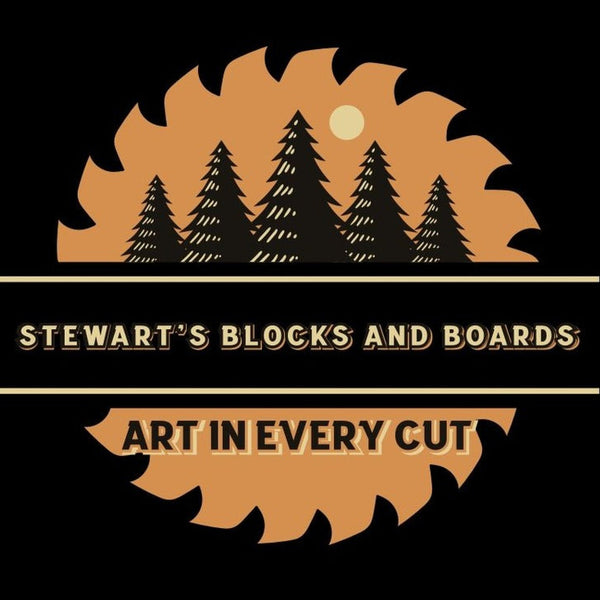
Creating DIY Handcrafted Cutting Boards
Share
Hello, fellow woodworking enthusiasts and aspiring craftsmen! If you've ever found yourself captivated by the beauty and functionality of a well-made cutting board, you're not alone. Handcrafted cutting boards are not only practical kitchen tools but also a stunning centerpiece for any culinary space. In this blog post, we'll explore the art of creating your very own DIY handcrafted cutting boards.
From understanding the right materials to use, to mastering techniques that bring out the best in your wooden creations, we'll guide you step by step through the process. Get ready to roll up your sleeves and bring a piece of art to life in your kitchen!
At Stewart's Blocks and Boards, we're passionate about woodworking and are here to support your creative journey. Let's dive into the world of handcrafted butcher blocks, explore the allure of the Handcrafted Lazy Susan, and maybe even expand our culinary adventures with some handy tools like the Pro Smart WiFi Wireless Meat Thermometer.
Choosing the Right Wood
The first step in creating a handcrafted cutting board is selecting the right type of wood. There are several wood species to choose from, each offering unique characteristics:
- Maple: Known for its durability and fine grain, maple is a favorite among woodworkers. It’s resistant to knife scars and provides a sturdy cutting surface.
- Walnut: Offering a rich color and striking grain patterns, walnut cutting boards add elegance to any kitchen.
- Cherry: This wood tends to darken over time, developing a beautiful, warm patina that enhances its visual appeal.
- Oak: With its open grain structure, oak is not only durable but also provides a rustic look that many find alluring.
Each of these wood types is not only visually appealing but also stands up well to the demands of daily culinary tasks. Remember, quality always trumps quantity when choosing wood for your handcrafted butcher blocks.
Tools of the Trade
Creating a cutting board involves more than just wood. The right tools make the process smoother and the results more professional. Here’s what you’ll need:
- Saws: A table saw or a miter saw can be used to cut the wood into the desired sizes for your board.
- Planer or Sander: Ensures your wood pieces are smooth and even.
- Clamps: Essential for holding the boards tightly as the glue sets.
- Router: This tool helps with creating rounded edges for a finished look.
- Wood Glue: A strong adhesive is necessary for joining the wood pieces together securely.
Step-by-Step Guide to Crafting Your Cutting Board
Step 1: Measure and Cut
Start by deciding on the size of your cutting board. Use a tape measure to mark the dimensions on your chosen wood. Use a saw to cut your planks according to these measurements.
Step 2: Sand the Edges
Use a planer or sander to smooth out any rough edges of the wood pieces. This will help them fit together seamlessly when glued side by side.
Step 3: Glue the Pieces
Apply wood glue to the edges of each piece and clamp them together. Make sure the wood pieces are aligned properly as you tighten the clamps. Leave them overnight so the glue can dry fully.
Step 4: Sand the Surface
Once the glue has set, remove the clamps and sand the surface of the board thoroughly, ensuring it is flat and smooth. This is where your board begins to take shape as a single piece.
Step 5: Final Touches
Use a router to round the edges of your board. This not only gives it a polished appearance but also ensures that there are no sharp corners.
Step 6: Treat the Wood
Finish your board by applying a food-safe mineral oil. This brings out the natural beauty of the wood and protects it from moisture.
Caring for Your Cutting Board
To ensure your handcrafted cutting board lasts for years, proper care is essential. Here are some tips:
- Regular Oiling: Apply mineral oil once a month to keep the wood hydrated and prevent cracking.
- Clean Properly: Wipe clean with mild soap and water after each use. Avoid soaking the board in water as it can warp the wood.
- Avoid Extreme Conditions: Keep the board away from extreme heat or cold. Avoid using it as a hot pad for pans.
For those who enjoy more than just cooking or crafting, why not add a high-tech twist to your culinary endeavors? The Pro Smart WiFi Wireless Meat Thermometer is a great tool for perfecting your grilling or roasting, making sure everything is cooked to perfection.
Expand Your Crafting Skills
Once you've mastered the cutting boards, why stop there? Consider branching out into other exciting projects:
Handcrafted Butcher Blocks: These larger, thicker counterparts to cutting boards serve as stunning, durable surfaces for serious food preparation.
Handcrafted Lazy Susan: Perfect for entertaining, a Lazy Susan adds functionality and style to your dining table. With the right techniques, you can create a beautiful rotating tray that’s sure to impress guests.
For those who prefer to season their creations to perfection, the ThermoMaven Electric Salt and Pepper Grinder Set can add a professional touch to your seasoning skills with its adjustable coarseness and convenient rechargeable design.
Conclusion
Creating DIY handcrafted cutting boards is not only a rewarding experience but an opportunity to learn and hone your woodworking skills. Whether you’re an amateur woodworker or a seasoned craftsman, the joy of bringing a piece of wood to life with your hands is unparalleled.
With every cut and slice, your cutting board tells a story – of the meals it has helped prepare and the hands that crafted it. As you venture into this creative journey, remember that each handcrafted piece is unique, a testament to your hard work and dedication to the craft.
At Stewart's Blocks and Boards, we're excited to be part of your journey. Explore our range of products and let your imagination run wild. Happy crafting!


